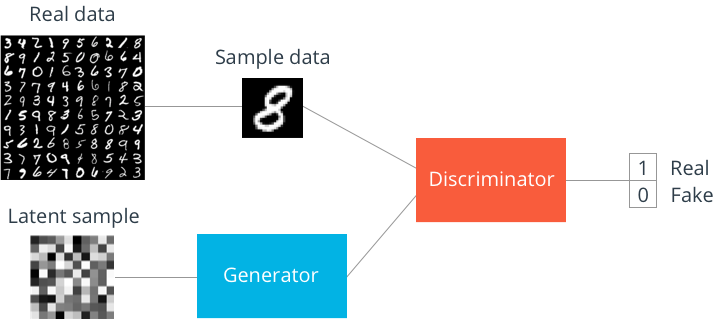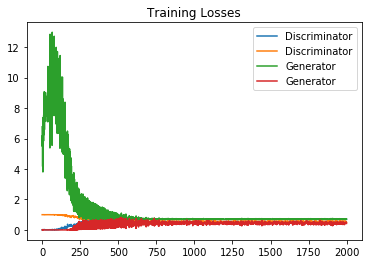Advanced Neural Network
Experimental environment
keras 2.1.5
tensor 1.4.0
Experimental tools
Jupyter Notebook
Experiment 1: MNIST generates antagonistic networks
thinking
Train two models, one to generate a given random noise as input output example G, and one to identify the generated model example A from the actual example.Then, by training A as an effective discriminator, we can overlay G and A into our GAN, freeze the weights of the antagonistic part of the network, and train the generated network weights to push the random noise input to the "real" class output of the antagonistic half class.
Work process:
Experimental process
1. Load Dependencies:
%matplotlib inline import numpy as np import matplotlib.pyplot as plt import keras from keras.layers import Dense, Activation, Dropout, Flatten, Reshape, LeakyReLU from keras.layers import Conv2D, Conv2DTranspose, UpSampling2D, BatchNormalization from keras.layers import Cropping2D from keras.datasets import mnist from keras.models import Sequential from keras.optimizers import RMSprop from sklearn.utils import shuffle
2. Loading and preparing datasets:
(x_train, y_train), (x_test, y_test) = mnist.load_data() x_train = x_train.astype("float32")/255.
Although the images are grayscale, we will increase the channel dimension by 1 because the convolution layer requires them.
x_train = x_train.reshape((x_train.shape[0],x_train.shape[1],x_train.shape[2],1)) x_test = x_test.reshape((x_test.shape[0],x_test.shape[1],x_test.shape[2],1)) y_train = y_train.reshape((y_train.shape[0],-1)) y_test = y_test.reshape((y_test.shape[0],-1)) train_data_shape = x_train.shape test_data_shape = x_test.shape train_label_shape = y_train.shape test_label_shape = y_test.shape #Take a look at the output: print("train data shape:",train_data_shape) print("train label shape:",train_label_shape) print("test data shape:",test_data_shape) print("test label shape:",test_label_shape) ''' train data shape: (60000, 28, 28, 1) train label shape: (60000, 1) test data shape: (10000, 28, 28, 1) test label shape: (10000, 1) '''
3. Establish a network model:
Discriminator:
We set up a discriminator network to receive [1,28,28] image vectors and determine whether they are true or false by using multiple convolution layers, dense layers, large loss, and two element Softmax output layer encoding: [0,1]=false and [1,0]=true.
D = Sequential() dropout = 0.4 input_shape = train_data_shape[1:] D.add(Conv2D(16, 3, strides=2, input_shape=input_shape,padding='same')) D.add(LeakyReLU(alpha=0.2)) D.add(Dropout(dropout)) D.add(Conv2D(32, 3, strides=2, padding='same')) D.add(LeakyReLU(alpha=0.2)) D.add(Dropout(dropout)) D.add(Conv2D(64, 3, strides=2, padding='same')) D.add(LeakyReLU(alpha=0.2)) D.add(Dropout(dropout)) D.add(Flatten()) D.add(Dense(1)) D.add(Activation('sigmoid')) D.summary() optimizer1 = RMSprop(lr=0.0008, clipvalue=1.0, decay=6e-8) D.compile(loss='binary_crossentropy', optimizer=optimizer1,metrics=['accuracy']) ''' _________________________________________________________________ Layer (type) Output Shape Param # ================================================================= conv2d_1 (Conv2D) (None, 14, 14, 16) 160 _________________________________________________________________ leaky_re_lu_1 (LeakyReLU) (None, 14, 14, 16) 0 _________________________________________________________________ dropout_1 (Dropout) (None, 14, 14, 16) 0 _________________________________________________________________ conv2d_2 (Conv2D) (None, 7, 7, 32) 4640 _________________________________________________________________ leaky_re_lu_2 (LeakyReLU) (None, 7, 7, 32) 0 _________________________________________________________________ dropout_2 (Dropout) (None, 7, 7, 32) 0 _________________________________________________________________ conv2d_3 (Conv2D) (None, 4, 4, 64) 18496 _________________________________________________________________ leaky_re_lu_3 (LeakyReLU) (None, 4, 4, 64) 0 _________________________________________________________________ dropout_3 (Dropout) (None, 4, 4, 64) 0 _________________________________________________________________ flatten_1 (Flatten) (None, 1024) 0 _________________________________________________________________ dense_1 (Dense) (None, 1) 1025 _________________________________________________________________ activation_1 (Activation) (None, 1) 0 ================================================================= Total params: 24,321 Trainable params: 24,321 Non-trainable params: 0 _________________________________________________________________ '''
Gernerator:
Using the function API, we built a relatively simple generation model in Keras, took 100 random inputs, and finally mapped them to a [1, 28, 28] pixel to match the shape of the MNIST data.First, a dense set of 14*14 values is generated, then several filters of different sizes and number of channels are run, and the use of binary cross-entropy and adam optimizer are trained.We use Sigmiod on the output layer to help saturate the pixels to a 0 or 1 state instead of a gray scale between 0 or 1, and batch normalization to help speed up training and ensure a wide range of activations are used in each layer.
G = Sequential() dropout = 0.4 G.add(Dense(4*4*128, input_dim=100)) G.add(BatchNormalization(momentum=0.9)) G.add(Activation('relu')) G.add(Reshape((4, 4, 128))) G.add(UpSampling2D()) G.add(Conv2DTranspose(64, 3, padding='same')) G.add(BatchNormalization(momentum=0.9)) G.add(Activation('relu')) G.add(UpSampling2D()) G.add(Conv2DTranspose(32, 3, padding='same')) G.add(BatchNormalization()) G.add(Activation('relu')) G.add(UpSampling2D()) G.add(Cropping2D(cropping=((2, 2), (2, 2)))) G.add(Conv2DTranspose(16, 3, padding='same')) G.add(BatchNormalization(momentum=0.9)) G.add(Activation('relu')) G.add(Conv2DTranspose(8, 3, padding='same')) G.add(BatchNormalization(momentum=0.9)) G.add(Activation('relu')) G.add(Conv2DTranspose(1, 3, padding='same')) G.add(Activation('sigmoid')) G.summary() ''' _________________________________________________________________ Layer (type) Output Shape Param # ================================================================= dense_2 (Dense) (None, 2048) 206848 _________________________________________________________________ batch_normalization_1 (Batch (None, 2048) 8192 _________________________________________________________________ activation_2 (Activation) (None, 2048) 0 _________________________________________________________________ reshape_1 (Reshape) (None, 4, 4, 128) 0 _________________________________________________________________ up_sampling2d_1 (UpSampling2 (None, 8, 8, 128) 0 _________________________________________________________________ conv2d_transpose_1 (Conv2DTr (None, 8, 8, 64) 73792 _________________________________________________________________ batch_normalization_2 (Batch (None, 8, 8, 64) 256 _________________________________________________________________ activation_3 (Activation) (None, 8, 8, 64) 0 _________________________________________________________________ up_sampling2d_2 (UpSampling2 (None, 16, 16, 64) 0 _________________________________________________________________ conv2d_transpose_2 (Conv2DTr (None, 16, 16, 32) 18464 _________________________________________________________________ batch_normalization_3 (Batch (None, 16, 16, 32) 128 _________________________________________________________________ activation_4 (Activation) (None, 16, 16, 32) 0 _________________________________________________________________ up_sampling2d_3 (UpSampling2 (None, 32, 32, 32) 0 _________________________________________________________________ cropping2d_1 (Cropping2D) (None, 28, 28, 32) 0 _________________________________________________________________ conv2d_transpose_3 (Conv2DTr (None, 28, 28, 16) 4624 _________________________________________________________________ batch_normalization_4 (Batch (None, 28, 28, 16) 64 _________________________________________________________________ activation_5 (Activation) (None, 28, 28, 16) 0 _________________________________________________________________ conv2d_transpose_4 (Conv2DTr (None, 28, 28, 8) 1160 _________________________________________________________________ batch_normalization_5 (Batch (None, 28, 28, 8) 32 _________________________________________________________________ activation_6 (Activation) (None, 28, 28, 8) 0 _________________________________________________________________ conv2d_transpose_5 (Conv2DTr (None, 28, 28, 1) 73 _________________________________________________________________ activation_7 (Activation) (None, 28, 28, 1) 0 ================================================================= Total params: 313,633 Trainable params: 309,297 Non-trainable params: 4,336 _________________________________________________________________ '''
Generate regression models:
Use the functional API to combine the generation model with the resistance model.
D.trainable = False gan = Sequential() gan.add(G) gan.add(D) gan.summary() optimizer2 = RMSprop(lr=0.0004, clipvalue=1.0, decay=3e-8) gan.compile(loss='binary_crossentropy', optimizer=optimizer2, metrics=['accuracy']) ''' _________________________________________________________________ Layer (type) Output Shape Param # ================================================================= sequential_2 (Sequential) (None, 28, 28, 1) 313633 _________________________________________________________________ sequential_1 (Sequential) (None, 1) 24321 ================================================================= Total params: 337,954 Trainable params: 309,297 Non-trainable params: 28,657 _________________________________________________________________ '''
4. Training:
Define a function to draw and save the output of the generator:
def plot_images(save2file=False, fake=True, samples=16, noise=None, step=0): filename = 'mnist.png' if fake: if noise is None: noise = np.random.uniform(-1.0, 1.0, size=[samples, 100]) else: filename = "mnist_%d.png" % step images = G.predict(noise) else: i = np.random.randint(0, self.x_train.shape[0], samples) images = x_train[i, :, :, :] plt.figure(figsize=(10,10)) for i in range(images.shape[0]): plt.subplot(4, 4, i+1) image = images[i, :, :, :] image = np.reshape(image, [train_data_shape[1], train_data_shape[2]]) plt.imshow(image, cmap='gray') plt.axis('off') plt.tight_layout() if save2file: plt.savefig(filename) plt.close('all') else: plt.show()
Set superparameters:
save_interval = 20 #save a plot that includes the output of the generator every number of steps train_steps=2000 # end number of steps start_step = 0 # start number of steps batch_size=256 # batch size
Discriminant models are pre-trained, several random images are generated using untrained generation models, connected to the same number of real digital images, tagged appropriately, and fitted until we reach a relatively stable loss value, which exceeds 20,000 examples.
num_pretrain = 5000 images_train = x_train[np.random.randint(0,x_train.shape[0], size=num_pretrain), :, :, :] #selecting random num_pretrain images from training data noise = np.random.uniform(0, 1.0, size=[num_pretrain, 100]) #generating random num_pretrain noise vectors images_fake = G.predict(noise) #generating fake images from the generator x = np.concatenate((images_train, images_fake)) #stacking both real and fake images #generating labels in which real=1, fake =0 y = np.ones([2*num_pretrain, 1]) y[num_pretrain:, :] = 0 x,y = shuffle(x,y) #shuffling the data and labels d_loss = D.fit(x, y, batch_size=batch_size, epochs=1, validation_split=0.15) #the pretraining step ''' Train on 8500 samples, validate on 1500 samples Epoch 1/1 8500/8500 [==============================] - 3s 335us/step - loss: 0.1738 - acc: 0.9426 - val_loss: 0.0033 - val_acc: 1.0000 '''
Generators can be trained in an overlay model of two networks.
The core of GaN training is as follows:
(1) G and random noise are used to generate the image (pass forward only).
(2) Perform batch updates of weights in a given generated image, real image, and label.
(3) Perform a batch of updates weighting the noise given in G and force the "true" label throughout the GaN.
(4) Repeat...
#noise input for generator output plotting noise_input = None if save_interval>0: noise_input = np.random.uniform(0.0, 1.0, size=[16, 100]) #the training loop d_losses = [] g_losses = [] for i in range(start_step,train_steps): # train the discriminator 2 times for dis_iter in range(1): #training the discriminator images_train = x_train[np.random.randint(0,x_train.shape[0], size=batch_size), :, :, :] #selecting random real images whose count equals the batch size noise = np.random.uniform(0.0, 1.0, size=[batch_size, 100]) # generating the noise vectors whose count equals batch size images_fake = G.predict(noise) #generate fake images from generator x = np.concatenate((images_train, images_fake)) #stack real and fake images #generating the labels y = np.ones([2*batch_size, 1]) y[batch_size:, :] = 0 # Add random noise to the labels - important trick! # y += 0.05 * np.random.random(y.shape) x,y = shuffle(x,y) #shuffling the images and labels d_loss = D.train_on_batch(x, y) #train the discriminator on this batch of data d_losses.append(d_loss) #training the adverserial model, aka training the generator y = np.ones([batch_size, 1]) #the labels, they are always one noise = np.random.uniform(0.0, 1.0, size=[batch_size, 100]) #input noise for generator g_loss = gan.train_on_batch(noise, y) #train the adeveserial model, with the discrimimator frozen only the generator is updated\ # and with all the labels equal (1), we are telling the generator to strive to generate data that will make the] # discriminator always output (1) aka fooling it. g_losses.append(g_loss) #print the losses and accuracy values log_mesg = "%d: [D loss: %f, acc: %f]" % (i, d_loss[0], d_loss[1]) log_mesg = "%s [G loss: %f, acc: %f]" % (log_mesg, g_loss[0], g_loss[1]) print(log_mesg) #save the plots of generator outputs if save_interval>0: if (i+1)%save_interval==0: plot_images(save2file=True, samples=noise_input.shape[0],noise=noise_input, step=(i+1)) ''' #Wait a long time, don't switch it off easily. 0: [D loss: 0.005583, acc: 1.000000] [G loss: 6.771719, acc: 0.000000] 1: [D loss: 0.004642, acc: 1.000000] [G loss: 5.488572, acc: 0.003906] 2: [D loss: 0.006872, acc: 1.000000] [G loss: 6.208431, acc: 0.000000] 3: [D loss: 0.008283, acc: 1.000000] [G loss: 4.167761, acc: 0.015625] 4: [D loss: 0.011295, acc: 0.998047] [G loss: 6.652860, acc: 0.000000] 5: [D loss: 0.020132, acc: 0.994141] [G loss: 3.805618, acc: 0.023438] ······ //Omit thousands ······ 1995: [D loss: 0.686364, acc: 0.550781] [G loss: 0.707710, acc: 0.433594] 1996: [D loss: 0.682135, acc: 0.552734] [G loss: 0.706227, acc: 0.460938] 1997: [D loss: 0.682364, acc: 0.552734] [G loss: 0.696030, acc: 0.519531] 1998: [D loss: 0.687504, acc: 0.529297] [G loss: 0.695345, acc: 0.511719] 1999: [D loss: 0.692645, acc: 0.498047] [G loss: 0.717447, acc: 0.425781] '''
5. Drawing:
fig, ax = plt.subplots() losses = np.array(g_losses) plt.plot(d_losses, label='Discriminator') plt.plot(g_losses, label='Generator') plt.title("Training Losses") plt.legend()


